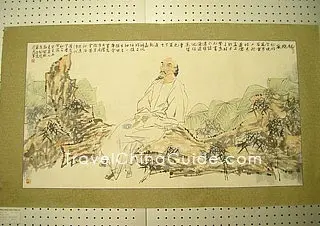Xuan Paper is recorded to be on the tribute items during the Tianbao Period in
Tang Dynasty (742-756), which suggests that Xuancheng area had already begun to produce paper at that time. From
Song to
Yuan Dynasty, local people were able to use Tara wingceltis bark as the raw material to make Xuan Paper in a systematic way. During Xuande Period in
Ming Dynasty (1426-1435), Xuan Paper was so popular that its making process was even supervised by the imperial court.
Different Types of Xuan Paper
According to the processing stage, Xuan Paper can be classified into raw paper (Sheng Xuan), processed paper (Shu Xuan) and semi-processed paper (Ban Shu Xuan). Sheng Xuan has the best ability of ink absorption, thus can quickly reflect the every subtle change of the writing brush. Thus, beginners are not recommended to use this type of Xuan Paper. Shu Xuan doesn’t absorb ink quickly because it is coated with gum and white alum. So, it is suitable for
paintings or
calligraphies with fine and delicate strokes. However, Shu Xuan can be a little bit brittle. The third type is Ban Shu Xuan, whose water absorption is between the former two because of the golden and silver particles on its surface; it is the most frequently used.
According to the content of Tara wingceltis bark in the paper, Xuan Paper can also be classified into Mian Liao containing 40% of Tara wingceltis bark, Jing Pi containing 60% of Tara wingceltis bark and Te Pi containing 80% of Tara wingceltis bark. Higher content of Tara wingceltis bark will enable the paper to sustain more friction of writing brush, so as to better present the charm of stroke.
Apart from the processing stage and the content of raw material, Xuan Paper can also be classified on the basis of thickness.
Five Tips for Using Xuan Paper

1. Test the paper’s quality first: Before painting or writing on Xuan Paper, you can place a drop of ink on the margin of the paper and observe how quickly it diffuses. If the ink diffuses quickly, you should use thick ink and write or paint faster. If the ink diffuses more slowly, you can dilute the ink depending on your needs.

2. Prevent the paper from moving: Xuan Paper is very light, thus can easily move with your writing brush. In order to keep Xuan Paper in place, you can use a paperweight or letterweight to secure it.

3. Prevent the ink from exuding: If there is too much ink on the brush or your stroke is powerful, the ink may exude through the paper and smear the table. Thus, you’d better put a piece of tissue or cloth under the paper.

4. Let the ink dry itself: After writing or painting, it will take a few minutes for the ink to dry. Do not use anything else like tissue to wipe the paper surface, otherwise the ink may easily blur and fade away.

5. How to preserve Xuan Paper: Damp and over-dryness can both cause damage to Xuan Paper. You need to keep it in a cool, airy and shady place and also protect it from being worm-eaten.
Six Basic Steps to Make Xuan Paper
There are more than one hundred process steps for making Xuan Paper. These steps can be generalized into six groups, including raw material selecting, pulp making, paper molding, paper heating, inspection and paper cutting. The paper molding, heating and cutting are of vital importance when making superior Xuan Paper.

1. Raw material selecting: Tara wingceltis bark and shantian straw need soaking, cleaning, steaming, boiling and airing first, before being made into bark pulp and straw pulp respectively.

2. Pulp Making: Different type of Xuan Paper needs different ratio of bark pulp to straw pulp.

3. Paper molding: Once the final paper pulp is mixed, it will be poured into a flat and rectangular paper mold. The mold filled with pulp will then be dipped into water tank to let the pulp condense evenly. Every piece of molded paper is within the error of one gram. This step needs two experienced craftsmen; one is in charge of lifting the mold and the other in charge of the strength and speed of lifting.

4. Paper drying: Every piece of wet paper needs to be torn off from the mold at a proper angle and speed to avoid any breakage. Then, the craftsman will use a brush made of pine needles to attach this piece of Xuan Paper on a hot wall to let it dry. Brushing is also a demanding job since it helps to prevent wrinkles appearing.

5. Inspection: Deficient paper will be discarded.

6. Paper cutting: Paper will be cut into different sizes.
- Last updated on Aug. 07, 2025 by Gabby Li -

